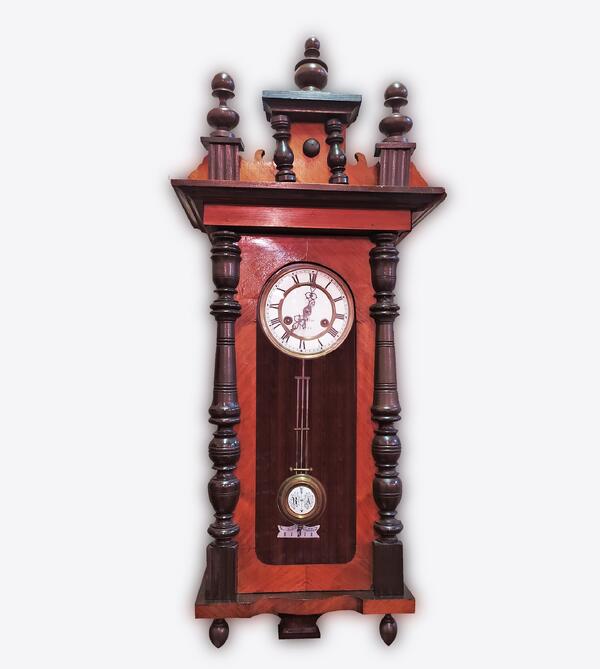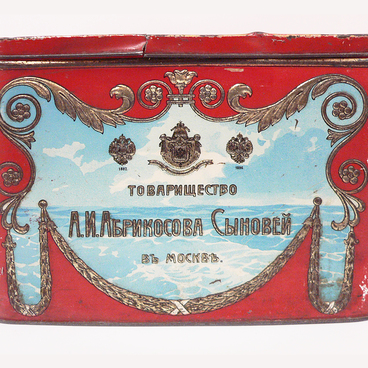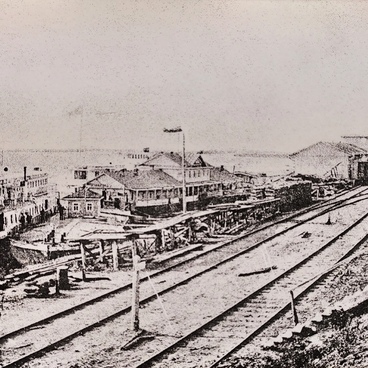The collection of the Kótlas Museum of Local Lore contains this old clock titled ‘Le Roi à Paris’, which translates as ‘The King of Paris.’ Several German factories were involved in the production of mechanical clocks under this brand, the largest of which were Schlenker-Kienzle, Yunghans, FMS and PHS. Under the brand name ‘Le Roi à Paris’, wall clocks were imported en masse into the Russian Empire at the beginning of the 20th century, because wealthy Russians wanted to have watches in their homes of German quality, but of beautiful French design.
The ‘Le Roi a Paris’ wall clock was in a more inexpensive category, accessible to the general population. It was a spring-wound mechanical clock with enamel dials, vaguely reminiscent of the ‘Vienna Regulators, ” which were high quality clocks produced by Austrians and Germans.
Marking dials with the inscription “Le Roi à Paris” was a marketing ploy with the intention to attract customers. The Germans managed to use the name of this famous French company, in operation since the end of the 18th century, without consequence. It is possible the brand “Le Roi à Paris” was not registered in Germany. The Schlenker-Kienzle company only officially registered the old trademark “Le Roi à Paris” on March 16, 1909. Since then, the inscription “Le Roi à Paris” can be generally be found only on the wall clocks manufactured by Kienzle.
This museum exhibit clock has a wooden case, covered with dark lacquer. The front and side casings are constructed in the form of frames with transparent glass, and the back casing is wooden. The front casing can be opened or locked in the closed position with a folding hook. The craftsmen fitted tailored columns along the side edges of the front casing, and the upper edge of the front casing was covered with a wooden overlay.
On the upper side of the body there is a wide wooden cover, into the front edge of which a wooden pediment is inserted. Inside, a bronze figured plate was attached to the back wall of the clock in the upper portion, on which there are two brackets for fastening the clock mechanism. On the plate there are embossed curls and the emblem of the “DLER GONG” company. The exhibit features a clock face covered with white enamel, with the inscription “Le Roi à Paris”. On the pendulum, the master placed a white enamel insert with the image of an arrow and the letters “R A” against the background of a floral ornament.
The ‘Le Roi a Paris’ wall clock was in a more inexpensive category, accessible to the general population. It was a spring-wound mechanical clock with enamel dials, vaguely reminiscent of the ‘Vienna Regulators, ” which were high quality clocks produced by Austrians and Germans.
Marking dials with the inscription “Le Roi à Paris” was a marketing ploy with the intention to attract customers. The Germans managed to use the name of this famous French company, in operation since the end of the 18th century, without consequence. It is possible the brand “Le Roi à Paris” was not registered in Germany. The Schlenker-Kienzle company only officially registered the old trademark “Le Roi à Paris” on March 16, 1909. Since then, the inscription “Le Roi à Paris” can be generally be found only on the wall clocks manufactured by Kienzle.
This museum exhibit clock has a wooden case, covered with dark lacquer. The front and side casings are constructed in the form of frames with transparent glass, and the back casing is wooden. The front casing can be opened or locked in the closed position with a folding hook. The craftsmen fitted tailored columns along the side edges of the front casing, and the upper edge of the front casing was covered with a wooden overlay.
On the upper side of the body there is a wide wooden cover, into the front edge of which a wooden pediment is inserted. Inside, a bronze figured plate was attached to the back wall of the clock in the upper portion, on which there are two brackets for fastening the clock mechanism. On the plate there are embossed curls and the emblem of the “DLER GONG” company. The exhibit features a clock face covered with white enamel, with the inscription “Le Roi à Paris”. On the pendulum, the master placed a white enamel insert with the image of an arrow and the letters “R A” against the background of a floral ornament.



